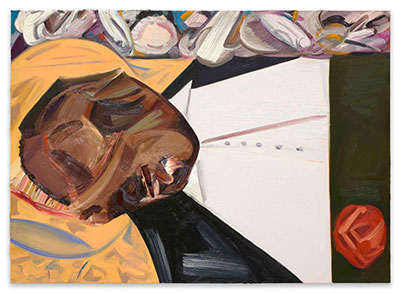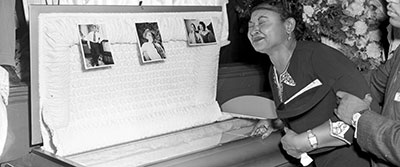I hadn’t planned on writing about this topic this week. In fact, I didn’t think that there needed to be yet another think piece about it but there was such an uproar that I couldn’t help but think that maybe there might be value to bringing the conversation a little closer to this side

of the world.
About two weeks ago the international art scene erupted after the opening of this year’s Whitney Biennial in New York. While the overarching theme seemed to invite artists to respond to their place in a “turbulent society” it was the work of one particular artist that drew a rigid divide among artists, critics, curators and everyone in between.
Dana Schutz, a Michigan-born artist, was one of sixty-three participants whose work was on display at the gallery and it was her painting titled “Open Casket” based on the photograph of fourteen-year-old Emmett Till’s mutilated face that was the source of contention. Why? Simply put, because Schutz is a White American woman who chose to paint a young Black man whose life ended violently after a White woman accused him of speaking inappropriately to her, a story she admitted was fabricated decades later on her deathbed. In fact it was in January of this year that Timothy Tyson, author of The Blood of Emmett Till revealed that Till’s accuser Carolyn Bryant Donham admitted to lying about him making advances saying, “That part’s not true.”
This recent revelation would have no doubt reignited intense feelings about Till’s case, race relations and the incredible miscarriage of justice in the U.S. But it wasn’t the fact that Schutz chose to paint Till that I believe was the issue, it was the photograph she chose to paint and the manner in which she painted it. There are photographs of Till, few though they may be, where he is seen smiling with the same kind of hopefulness most youths have. Schutz instead chose to paint the photograph of Till’s mutilated face visible from his open casket on the day of his funeral.
The interesting part of the Emmett Till story for those familiar with it, was his mother’s insistence that the casket remain open so that everyone could see the graphic evidence of what was done to her son. She wanted the photographs subsequently taken to be made public and was quoted as saying, “I know that his life can’t be returned but I hope that his death will certainly start a movement in these United States.” And months later it did help to trigger a new development in the American Civil Rights Movement in the form of the yearlong Montgomery Bus Boycott.
Although his mother wanted the photograph to be seen by everyone everywhere, what right does it give contemporary creative practitioners to reinterpret said photograph and does that answer change if someone of a different race chooses to produce their own reinterpretation? Of course no one can dictate what an artist should produce. That is not how it works. But while it would seem as though nothing is off limits to us, it is our responsibility (in my opinion) to be respectful in the handling of such sensitive history.
I can understand the outrage because the issue isn’t as simple as a White woman choosing to paint a Black young man whose violent death was a result of a racially divided South. It’s also about the kind of privilege that shielded (and still shields) a very specific group of people from any form of accountability. It’s about representation and controlling images of a race continuously under attack. It also calls to mind how blatantly biased U.S. media houses are when choosing photographs of suspected criminals of different races to accompany their news articles. And all of these things are culminating at a time when we’re constantly bombarded with photographs and video footage of innocent Black men being killed in the U.S.
It’s easy to become desensitized to graphic images if you’re forced see them often enough. Those dead bodies eventually aren’t dead bodies anymore. They become reduced to statistics and hash tags trending on social media. Personally, I can’t help but feel as though the decision of Till’s mother to encourage the circulation of that photograph made it easier for people like Schutz to casually use it as source material forgetting that Till was a human being, and not some grotesque life-sized doll to be fetishized. And there’s such an extensive, centuries-long history of Black bodies being fetishized as the “other.”
In a letter written to the gallery by a group of artists and curators protesting the painting Schutz was accused of, among other things, “…[transmuting] black suffering into profit and fun […]” Schutz later stated that it was never her intention to sell the painting and that she assumed the position of a mother who lost their only child, effectively empathizing with Mamie Till-Mobley. No one can say for sure if this was indeed her intention or if it was simply a last ditch effort to save face amidst mounting protests.
However, I would’ve imagined her connecting more deeply with the many photographs of his mother weeping beside his open casket. That, for me, would’ve been a much more effective way of showing empathy. But again, we don’t dictate what an artist should paint. Still, her decision (which one could argue that she need not defend or explain) to use the photograph she did makes me think of her in the position of the undertaker rather than mother. There is a certain disconnect between Schutz the painter and Till the painted, where it feels more clinical than it does emotional. The manner in which she “tended” to the wounds on his face with her brush, sanitizing and practically erasing the power of the details of the photograph that Mamie Till-Mobley relied on so heavily makes it extremely difficult for me to see the mother-child relationship Schutz wants us to see.
Regardless, my opinion is that Schutz is allowed to paint whatever she wants to, like any creative individual. I don’t believe in censorship but I do believe that if you choose to take on such a heavy topic you must be aware of the implications and you must add something of value to the public’s understanding of said topic. In the same way I’m allowed to say that her painting adds nothing of value to the conversation about racially driven violence against Black male bodies, specifically the Black male body of Emmett Till. Her attempt to reinterpret the photograph is weak and it romanticizes the gruesome wounds his mother wanted the world to see by blurring the details only a photograph could effectively capture.
I also don’t particularly care if her intention for the painting was sincere nor do I wish to see her painting destroyed as many have since called for. But I do believe that calling for the destruction of any work of art because it is considered offensive by any group sets a dangerous precedent that we simply cannot afford at any point in time, particularly now when opinions about everything are so polarized. What is the role of the artist if not to critique these issues by offering his or her own visual response? We cannot have healthy conversations across the board by blocking the other party’s opinion whenever it doesn’t align with our own.
I believe there’s a danger in holding on to certain traumas and claiming them as belonging only to any one particular group of people, effectively shutting out other groups from responding to that pain (if they so desire). And while I understand both sides of this particular situation, I feel strongly about the fact that we need to be more inclusive of others when engaging with traumatic subjects that trigger intense emotions. That inclusion could hopefully be one of the steps necessary for the beginning of a more thorough healing process for all parties involved. My philosophy has always been that there’s a learning moment in everything for everyone regardless of his or her position on the subject in question.




.png)









